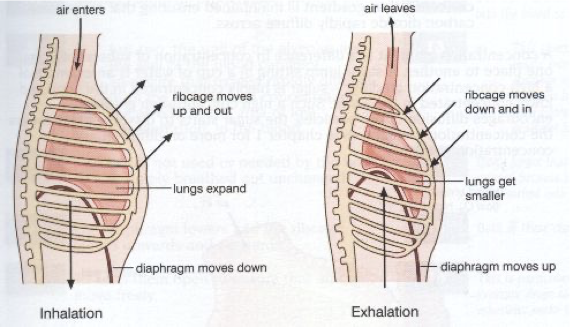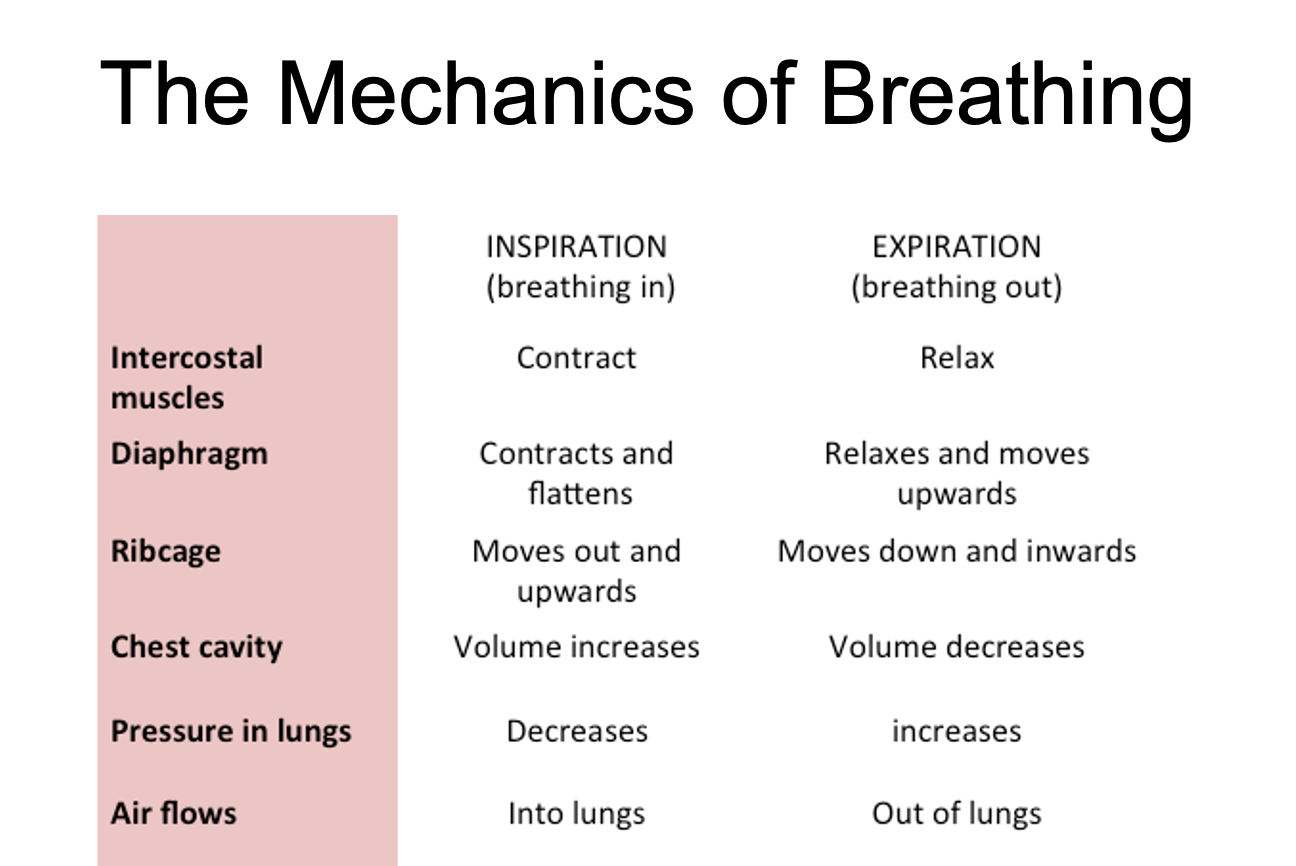human bio
Structures of the Respiratory system
Nasal Cavity: The primary entry point for air, which is filtered, warmed, and moistened.
Pharynx: The throat region that serves as a passageway for both air and food.
Larynx: Also known as the voice box, it contains the vocal cords and is responsible for sound production.
Trachea: The windpipe that connects the larynx to the bronchi, allowing air to flow into the lungs.
Bronchi: The two main branches that split from the trachea and lead into each lung.
Bronchioles: Smaller air passages that extend from the bronchi and lead to the alveoli.
Alveoli: Tiny air sacs in the lungs where gas exchange occurs between oxygen and carbon dioxide. Their function is GAS EXCHANGE i.e. diffusion of gases between alveoli and blood capillaries.
Diaphragm: A dome-shaped muscle that separates the chest cavity from the abdominal cavity and plays a crucial role in breathing by contracting and relaxing to facilitate airflow. when you breath in the diaphragm contacts and flatterns , when you breath out your diaphragm relaxes and moves upwards.
During Inspiration: the diaphragm contracts and flattens, increasing chest volume.
During Expiration: diaphragm relaxes, pushing up into chest cavity to decrease chest volume.
Lungs: The paired organs located in the thoracic cavity that are responsible for the exchange of gases; they expand and contract during breathing, allowing oxygen to be absorbed into the bloodstream and carbon dioxide to be expelled.
Intercostal Muscles: These muscles are found between the ribs. They are responsible for increasing or decreasing the volume of the chest cavity.
cilla: hair like persecutions that move dust out of the airway
Passage of air into lungs:
•Air goes into nose and mouth
•Pharynx passes air to trachea
•Trachea then spilts into two primary bronchi (left and right)
•Bronchi then divide into secondary and tertiary bronchi
•Air travels into bronchioles and then into
•Alveoli (air sacs)
Mechanics of Breathing:
inspiration: occurs when the intercostal muscles contract, lifting the rib cage and expanding the chest cavity, which decreases the internal pressure and allows air to flow into the lungs.
expiration: occurs when the intercostal muscles relax, causing the rib cage to lower and the chest cavity to decrease in volume, which increases internal pressure and forces air out of the lungs.


Characteristics of Alveoli for Efficient Gas Exchange
1. Large Alveoli Surface area
•large amounts of gas can be exchanged in a short amount of time
2. Large Blood Supply
•Each alveolus is well supplied with blood capillaries.
•Blood is close to the air in the alveolus
•Continual flow maintains the difference in oxygen and carbon dioxide concentration (diffusion gradient)
3.Thin wall
Membrane of wall of alveolus is 1 micrometre thick so only a short distance for gases to travel - easy for gas exchange
4. Moist Alveolus Membrane
Gases can diffuse into and out of the blood only when they are dissolved in fluid
Membranes of the alveolus are covered by a layer of moisture.
5. Lung Positioning
•Lungs are deep inside the body, preventing excessive evaporation of fluid from alveoli
Enzymes
•Enzymes are catalysts found in living things
•Catalysts speed up chemical reactions
•They are simple protein molecules
•They are not alive / can’t be “killed”
•They can be used repeatedly
Activation Energy
A catalyst (eg. enzyme)
•INCREASES the reaction rate
•Lowers activation energy
•Is not consumed (used up) by the reaction (can be used again)]
activation energy
lock and key model
enzymes have unique shapes that fit with specific molecules
they help with metabolic chemical reactions
put molecules together and break them apart
definitions
substrate: The model substance that the enzymes acts on
active site : parts of the enzymes the substrate attaches to binds
enzymes substrate complex : a temporary molecules formed when a enzymes comes into defer contact with it’s substance
product : molecules that are produced after the enzymes acts on the substance
Factors effecting enzymes activity
temperature
increased kinetic energy ( motion in particles) leads to increased frequency of effective collisions between enzymes and substrates more reaction
when temp increases so dose the kinetic energy which means they are moving fast
enzymes get denatured if over 45C
enzymes work slower in colder weather
the work best in 30 - 40C
Ph
enzymes function in a certain range of ph
eg stomach = acidic
protease acts in stomach but another enzymes may not eg amylase &lipase
Digestion
The process of breaking down food into simpler substances to be absorbed into the blood and into the cells
Types of digestion
mechanical and physical digestion
the physical of breaking down food into smaller pieces eg teeth and bile
mechanical digestion
Mechanical digestion is the physical process that breaks food down into smaller pieces without changing its chemical composition
chemical digestion
chemical break down of food from a large molecule into a smaller molecule which is cause by enzymes
parts of the digestion system
the digestive system if mad up of alimentary canel and accessory organs
alimentary
extend from mouth to anus forming a continuous tube
alimentary canel and digestive system are not the same thing
accessory organ
plays a vital role in digestion and secretion of enzymes include salivary gland liver gall bladder and pancreas
organs of digestion system carry out 6 basic activities